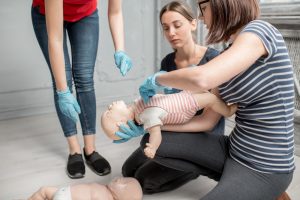 As new parents, you’re not expected to know everything. However, there are certain things that should be a top priority for all caregivers, and that’s learning infant and child CPR (cardiopulmonary resuscitation) and the Heimlich maneuver for preventing choking.
As new parents, you’re not expected to know everything. However, there are certain things that should be a top priority for all caregivers, and that’s learning infant and child CPR (cardiopulmonary resuscitation) and the Heimlich maneuver for preventing choking.
CPR involves chest compressions and rescue breathing to bring oxygen into the lungs and keep the blood flowing. The Heimlich maneuver involves abdominal thrusts on children over the age of 1 and a series of focused back slaps on babies or infants to stop them from choking. While you never want to be in a position to have to use these, if an emergency arises, you’ll be thankful that you added CPR and Heimlich maneuver to your list of lifesaving parenting skills.
Highlights:
|
Infant/Child CPR and Heimlich Maneuver
First, it’s important to know that infant/child CPR and the Heimlich maneuver are different from adult emergency response methods, so it’s imperative for parents and caregivers to learn the proper techniques. If you’ve taken emergency response classes in the past, you might have only learned to use these emergency response methods on adults. If you haven’t already done so, it’s highly advised to sign up for an infant/child CPR and choking prevention class with a certified instructor.
Why it’s Important to Learn CPR and the Heimlich Maneuver
It’s probably not hard to imagine why learning CPR and choking prevention techniques designed for infants and young children is important. There are hundreds of scary scenarios that can cause a child to stop breathing. We won’t list every potentially terrifying situation. However, it’s crucial to know that a baby or toddler may need CPR if they’ve been in an accident, had an electrocution injury, fallen in the pool, inhaled smoke, or are at risk of SIDS (sudden infant death syndrome).
Because babies learn through sensory input, they’re prone to placing objects in their mouths. Common items found around the house, like pen caps, coins, or small pieces of jewelry, can immediately become a choking hazard when in a little one’s reach. Toddlers often fidget and move as they eat, so small pieces of food, like cut-up hot dogs, grapes, or cheese cubes, can suddenly block their airway and cause them to choke. Even with a watchful eye and proper safety precautions, accidents happen. Learning how to stop a young child from choking is a critical life lesson.
When a child stops breathing, the blood stops circulating, and the brain becomes starved of oxygen. If there’s no emergency response within minutes, permanent brain damage can occur, or a child’s life can be at risk. Taking the BabySparks Infant and Child CPR and Choking Prevention class from our certified instructor can help you learn:
- How to position an infant and child to prepare them for CPR
- How to perform CPR on an infant and child
- How to perform the Heimlich maneuver on a child who is choking
- How to alleviate choking in an infant
- When to call for emergency services
Knowing how to administer infant/child CPR, and the Heimlich maneuver can give you peace of mind. Being prepared with the right child safety skills can help you take control of an unpredictable crisis.








